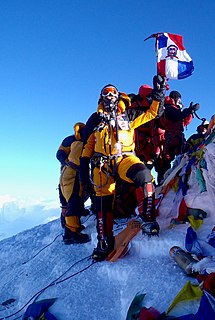
The Four Corners is a region of the United States consisting of the southwestern corner of Colorado, southeastern corner of Utah, northeastern corner of Arizona, and northwestern corner of New Mexico. The Four Corners area is named after the quadripoint at the intersection of approximately 37° north latitude with 109° 03' west longitude, where the boundaries of the four states meet, and are marked by the Four Corners Monument. It is the only location in the United States where four states meet. Most of the Four Corners region belongs to semi-autonomous Native American nations, the largest of which is the Navajo Nation, followed by Hopi, Ute, and Zuni tribal reserves and nations. The Four Corners region is part of a larger region known as the Colorado Plateau and is mostly rural, rugged, and arid. In addition to the monument, commonly visited areas within Four Corners include Monument Valley, Mesa Verde National Park, Chaco Canyon, Canyons of the Ancients National Monument and Canyon de Chelly National Monument. The most populous city in the Four Corners region is Farmington, New Mexico, followed by Durango, Colorado.
The Rural Municipality of Frenchman Butte No. 501, Saskatchewan, a Canadian province, began as an area of 3 by 3 townships square of the Dominion Land Survey. Frenchman Butte No. 501 became a huge rural municipality absorbing both the original Rural Municipalities of North Star No. 531 on December 31, 1953 and Rural Municipality 532. Frenchman Butte No. 501 completely surrounds Seekaskooch First Nation Indian Reserve No. 119, and borders on Makaoo No. 120.
Shadow Butte is a mountain butte, located in the southwestern region of the U.S. state of Idaho.
Eagle Creek is a 58.5-mile-long (94.1 km) river located 50 miles (80 km) northwest of Clifton, Arizona, United States, at the base of the White Mountain Range. It is a tributary of the Gila River.
Blue is an unincorporated community in Greenlee County, Arizona, United States. It lies 33°36′36″N109°6′24″W, at an elevation of 5,758 feet (1,755 m). The community was originally named for Nat Whittum, an original settler who was killed at the site in 1891. A post office was established at Whittum in 1894; however, its name was changed to Blue in 1898, because everyone knew where the Blue River was but Whittum was not known. Blue has a ZIP Code of 85922; in 2000, the population of the 85922 ZCTA was 36. In addition to its post office, Blue also contains a public library, and a public school serving all grade levels.

Lomo is an unincorporated community in Butte County, California. It lies 4.5 miles (7.2 km) of Butte Meadows, at an elevation of 3779 feet. A post office operated at Lomo from 1878 to 1881.

Oak Grove is an unincorporated community in Butte County, California. It lies at an elevation of 128 feet.

Cottonwood is a census-designated place (CDP) in Apache County, Arizona, United States. The population was 226 at the 2010 census.

Sehili is a census-designated place (CDP) in Apache County, Arizona, United States. The population was 135 at the 2010 census.
San Simon River is an ephemeral river, or stream running through the San Simon Valley in Graham and Cochise County, Arizona and Hidalgo County, New Mexico. Its mouth is at its confluence with the Gila River at Safford in Graham County. Its source is located at 31°51′21″N109°01′27″W.

Laguña Creek also formerly also known as Tyende Creek, is a stream in the Navajo and Apache Counties of Arizona. Laguña Creek has its source at 36°41′15″N110°30′36″W, at the conflence of Long Canyon and Dowozhiebito Canyon at an elevation of 6325 feet / 1928 meters at the head of Tsegi Canyon. Its mouth is in the Chinle Valley at its confluence with Chinle Wash which together forms Chinle Creek, at an elevation of 4774 feet / 1455 meters. Chinle Creek is a tributary of San Juan River which is in turn a tributary of the Colorado River.
Chinle Wash is an arroyo, tributary to Chinle Creek in Apache County, Arizona. Its name is derived from the Navajo word ch'inili meaning 'where the waters came out'. Its sources is in Canyon de Chelly National Monument where Canyon de Chelly and Canyon del Muerto have their confluence at an elevation of 5,616 feet at 36°08′35″N109°29′17″W. It then trends northwest to its confluence with Laguña Creek where it forms Chinle Creek, 7 miles northeast of Dennehotso, Arizona at an elevation of 4,774 feet / 1,455 meters.

Chinle Creek is a tributary stream of the San Juan River in Apache County, Arizona and San Juan County, Utah. Its source is at 36°53′40″N109°44′37″W, the confluence of Laguña Creek with Chinle Wash where it forms Chinle Creek, 7 miles northeast of Dennehotso, Arizona at an elevation of 4,774 feet (1,455 m). Its mouth is at its confluence with the San Juan River at 37°11′53″N109°42′57″W at an elevation of 4,229 feet (1,289 m), 9 miles northeast of Mexican Hat, Utah.
Walker Creek is a stream in Apache County, Arizona. Its mouth is at an elevation of 4,688 feet / 1,429 meters at its confluence with Chinle Creek. Its source is located at 36°41′28″N109°15′04″W, the confluence of Alcove Canyon and Tah Chin Lini Canyon in the Carrizo Mountains, from which it flows west and northwest to Chinle Creek at 36°57′42″N109°41′35″W. Hogansaani Spring, a tributary, is located on the south side of Walker Creek, at an elevation of 5,102 feet (1,555 m), midway downstream Walker Creek to its confluence with Chinle Creek.
Bog Creek is a stream in Apache County of northeastern Arizona. It is a tributary to the North Fork White River.









